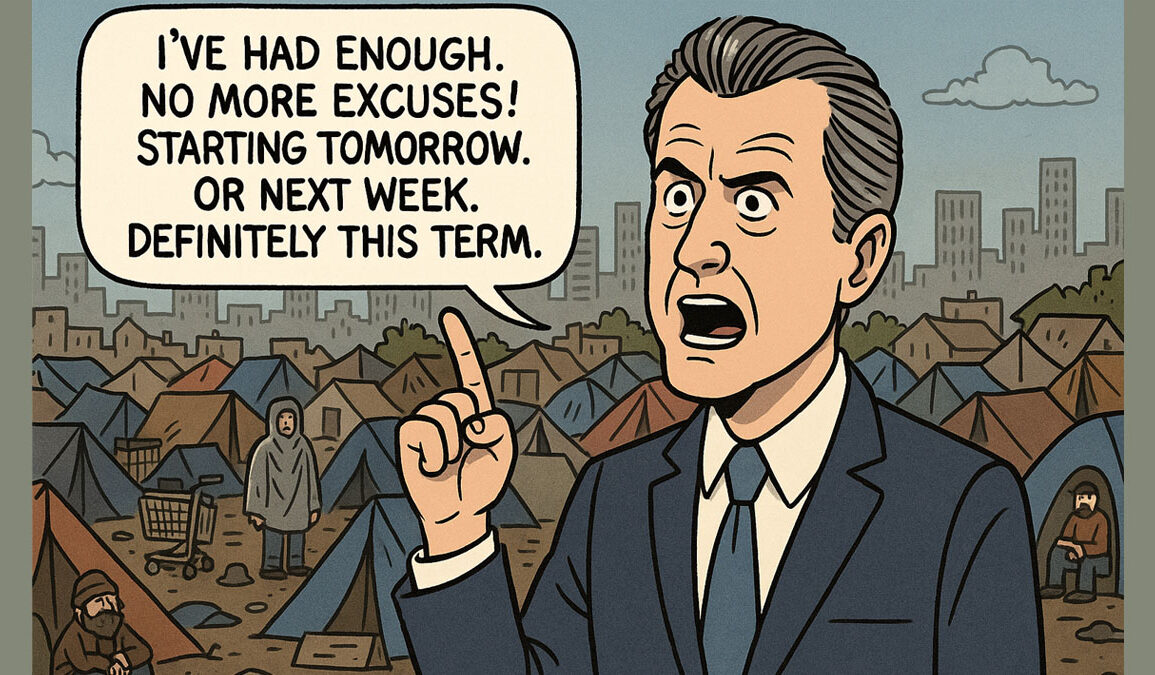Standing at the podium with the confidence of a man who just discovered the problem yesterday, California Governor Gavin Newsom announced what he’s calling an “aggressive new plan” to clear homeless encampments across the state.
“There’s nothing compassionate about letting people die on the streets,” Newsom said in his latest press release. “Local leaders asked for resources—we delivered the largest state investment in history. They asked for legal clarity—the courts delivered. Now, we’re giving them a model they can put to work immediately, with urgency and with humanity, to resolve encampments and connect people to shelter, housing, and care. The time for inaction is over. There are no more excuses.”
It was a passionate speech. It was also, for anyone who’s been awake the last five years, rich with irony. After all, Newsom has been in office since 2019 and has already spent an astonishing amount of money trying to fix homelessness. His own track record is a pile of promises, press releases, and press conferences—followed by very little progress.
The Numbers Don’t Lie. The Streets Speak for Themselves
Under Newsom’s watch, California has spent an estimated $27 billion attempting to address homelessness. That includes $17 billion in just the past four fiscal years. The result? California remains the epicenter of the nation’s homeless crisis. Despite making up only 12 percent of the U.S. population, the state is home to nearly half of the nation’s unsheltered homeless—roughly 115,000 people living in tents, vehicles, or on sidewalks.
Newsom’s office insists that things are finally turning around. They point out that in 2024, while the nation’s unsheltered homeless population rose by nearly 7 percent, California’s increase was just 0.45 percent. “Governor Newsom is the first governor to actively address this issue in our state,” said his office, “and he is reversing a crisis that was decades in the making.”
Critics, however, see it differently. The Wall Street Journal famously called California’s effort a “complete failure,” pointing out that even after billions in spending, the state’s homeless population is larger and more visible than ever. “You could practically assign a personal caseworker to every homeless person in the state for that kind of money,” one editorial joked. And still, the tents keep multiplying.
‘Proven and Workable’—If You Don’t Look Too Closely
Newsom’s new plan includes a model ordinance for cities and counties to adopt. It is supported by another $3.3 billion from Proposition 1, a ballot measure passed by voters in March 2024 to fund mental health housing and services.
The model ordinance, according to Newsom’s office, is built on a “proven and workable approach.” They claim that between July 2021 and May 2025, more than 16,000 encampments were cleared and over 311,873 cubic yards of debris were removed from areas near state highways. That’s a lot of trash. But critics note the glaring omission: how many of the people living in those encampments actually ended up in permanent housing?
The governor’s office insists the policy is both “effective and scalable,” but the evidence remains thin. In cities like Oakland, homeless camps continue to grow, and the fire department responded to 816 encampment fires in a single year. Sixty-three of those fires happened at just one location: the infamous Wood Street encampment, which had to be dismantled after a devastating blaze.
Local Blame Game Meets State Finger-Pointing
Newsom seems tired of cities not falling in line, saying his office has “actively held communities accountable who do not follow state law.” He even sued the city of Norwalk in 2024 for allegedly banning homeless shelters.
But local leaders say the blame is misdirected. They argue that many of the state’s programs are bogged down by bureaucracy, red tape, and funding delays. Even when cities are given housing vouchers, there is often nowhere for people to go. Housing costs are sky-high, and construction of new units has been painfully slow. The city of Oakland, for example, has repeatedly said it lacks enough shelter beds to meet the overwhelming demand.
Voters in cities like San Francisco and Los Angeles have approved new taxes to fund housing and services. Yet despite those efforts, projects often suffer from cost overruns, endless delays, and rules that make it nearly impossible to move quickly.
Mental Health Beds and Treatment Slots: Promises Round Four
As part of the new push, Newsom’s office announced plans to expand behavioral health care by using Prop 1 funds to build 5,000 new residential treatment beds and open over 21,800 outpatient slots. When all funding is awarded, they say the totals will reach 6,800 beds and 26,700 slots. It sounds impressive—until you compare it with the sheer number of people on the streets who need help now.
“Californians demanded swift action to address our state’s behavioral health crisis when they voted for Prop 1,” Newsom said. “Today, we’re delivering our biggest win yet.”
Kim Johnson, Secretary of the California Health and Human Services Agency, echoed the sentiment. “These projects are a reflection of our values and vision for a healthier, more compassionate California,” she said.
But not everyone is buying it. Critics say the announcement reads like a rehash of earlier promises that failed to deliver results. Michelle Baass, Director of the Department of Health Care Services, described the initiative as “a generational investment,” but for many Californians, it feels more like the same tune on repeat—with a bigger price tag each time.
‘Aggressive Action’ or Another Round of Press Releases?
The new plan is carefully worded to avoid saying whether breaking encampment rules will be criminalized. Instead, cities are encouraged to set their own enforcement standards. The guidelines claim to protect civil rights while allowing officials to clear camps “to protect the health and safety of their residents and maintain their public spaces.”
Some local leaders have already begun floating proposals to jail individuals who refuse housing, though that, too, is controversial. Homeless advocates warn that cracking down without adequate alternatives only pushes people further into the shadows.
“The false assumption that mandated treatment works better than voluntary treatment is just that—false,” said Bob Erlenbusch, a longtime advocate. Other critics point out that focusing too much on enforcement risks criminalizing addiction and mental illness, rather than solving the root issues.
Newsom now insists that the time for excuses is over. But for someone who has had the top job for five years and spent more than $27 billion with little to show for it, the statement feels like a punchline.
The governor is acting like he just got here. But the reality is, he has been here. He has tried. He has failed. And now he wants applause for trying again.
Newsom’s credibility is shot. Zero. But you can bet that he will try, especially after such a horrific disaster mishandling recent wildfires that caused billions of dollars.








